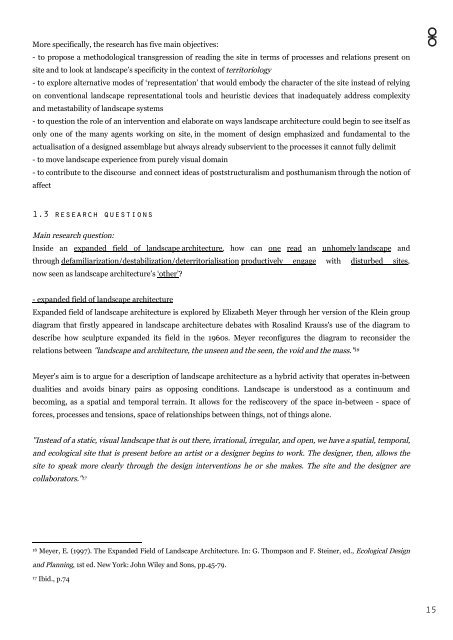Unfamiliar Territory_Research
Create successful ePaper yourself
Turn your PDF publications into a flip-book with our unique Google optimized e-Paper software.
More specifically, the research has five main objectives:<br />
- to propose a methodological transgression of reading the site in terms of processes and relations present on<br />
site and to look at landscape’s specificity in the context of territoriology<br />
- to explore alternative modes of ‘representation’ that would embody the character of the site instead of relying<br />
on conventional landscape representational tools and heuristic devices that inadequately address complexity<br />
and metastability of landscape systems<br />
- to question the role of an intervention and elaborate on ways landscape architecture could begin to see itself as<br />
only one of the many agents working on site, in the moment of design emphasized and fundamental to the<br />
actualisation of a designed assemblage but always already subservient to the processes it cannot fully delimit<br />
- to move landscape experience from purely visual domain<br />
- to contribute to the discourse and connect ideas of poststructuralism and posthumanism through the notion of<br />
affect<br />
⚮<br />
1.3 research questions<br />
Main research question:<br />
Inside an expanded field of landscape architecture, how can one read an unhomely landscape and<br />
through defamiliarization/destabilization/deterritorialisation productively engage with disturbed sites,<br />
now seen as landscape architecture’s ‘other’?<br />
- expanded field of landscape architecture<br />
Expanded field of landscape architecture is explored by Elizabeth Meyer through her version of the Klein group<br />
diagram that firstly appeared in landscape architecture debates with Rosalind Krauss's use of the diagram to<br />
describe how sculpture expanded its field in the 1960s. Meyer reconfigures the diagram to reconsider the<br />
relations between "landscape and architecture, the unseen and the seen, the void and the mass." 16<br />
Meyer's aim is to argue for a description of landscape architecture as a hybrid activity that operates in-between<br />
dualities and avoids binary pairs as opposing conditions. Landscape is understood as a continuum and<br />
becoming, as a spatial and temporal terrain. It allows for the rediscovery of the space in-between - space of<br />
forces, processes and tensions, space of relationships between things, not of things alone.<br />
"Instead of a static, visual landscape that is out there, irrational, irregular, and open, we have a spatial, temporal,<br />
and ecological site that is present before an artist or a designer begins to work. The designer, then, allows the<br />
site to speak more clearly through the design interventions he or she makes. The site and the designer are<br />
collaborators." 17<br />
16<br />
Meyer, E. (1997). The Expanded Field of Landscape Architecture. In: G. Thompson and F. Steiner, ed., Ecological Design<br />
and Planning, 1st ed. New York: John Wiley and Sons, pp.45-79.<br />
17 Ibid., p.74<br />
15


